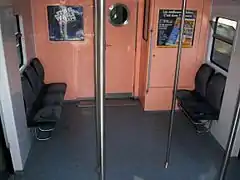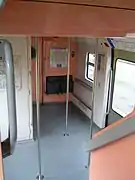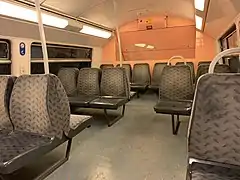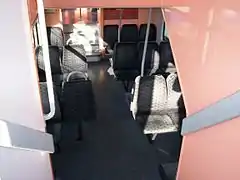SNCF Class Z 22500
The SNCF Class Z 22500, also known as the MI 2N Eole (French: Matériel d'Interconnexion à 2 Niveaux, Est Ouest Liaison Express, English: two-level interconnection rolling stock for the east west express link) is a double-deck, dual-voltage electric multiple unit trainset that is operated on line E of the Réseau Express Régional (RER), a hybrid suburban commuter and rapid transit system serving Paris and its Île-de-France suburbs. The trains are SNCFs version of the MI 2N and looks similar to the other variant, the MI 2N "Altéo" trains (operated by the RATP) but each features different motorization and interior layout.
| Z 22500 "MI 2N Eole" | |
|---|---|
 Class Z 22500 "MI 2N Eole" at Gare de l'Est | |
| In service | 1998–present |
| Manufacturer | GEC Alsthom and Bombardier |
| Family name | X'Trapolis |
| Constructed | 1997–2000 |
| Entered service | 1997–present |
| Number in service | 53 trainsets (265 cars) |
| Formation | 5 cars per trainset (DT+MC+T+MC+DT) |
| Fleet numbers | Z 22502/1 to Z 22605/6 |
| Capacity | 1,337 passengers |
| Operator(s) | SNCF |
| Depot(s) | Noisy-le-sec |
| Line(s) served | |
| Specifications | |
| Car body construction | Stainless steel |
| Train length | 112 m (367 ft 5 1⁄2 in) |
| Width | 2.9 m (9 ft 6 1⁄8 in) |
| Height | 4.32 m (14 ft 2 1⁄8 in) |
| Doors | 3 pairs per side, per car |
| Maximum speed | 140 km/h (87 mph) |
| Weight | 277T per trainset |
| Traction system | GEC Alsthom GTO VVVF motors |
| Traction motors | 4 FXA 3561 B asynchronous, 550V, force ventilated, 8 off |
| Power output | 3,200 kW (4,300 hp) (continuous) |
| Electric system(s) | 1.5 kV DC or 25 kV AC overhead catenary |
| Current collection method | Pantograph (type AX 25) |
| UIC classification |
|
| Safety system(s) | Crocodile, EAS and KVB |
| Coupling system | Scharfenberg type |
| Multiple working | 2x Z 22500 trainsets (regular service) |
| Track gauge | 1,435 mm (4 ft 8 1⁄2 in) standard gauge |
The 53 five-car trains were built by a consortium of French manufacturer Alstom (then known as GEC Alsthom) and Canadian conglomerate Bombardier. The final assembly of the trains was performed at Alstom's Valenciennes factory and Bombardier's Crespin factory between 1997 and 2000.
History
By the end of the 1980s, the RER A line had become the busiest in the system and the busiest single rail line outside of East Asia.[1][2] Overcrowding on the RER A was already the main transport problem in the greater Paris area. To address this issue, several projects were launched: the SNCF started construction of the Est Ouest Liaison Express (EOLE; English: east west express link) which would later be known as the RER E line, while the RATP started construction of the Paris Métro Line 14, both of which would both parallel the RER A in central Paris.
At about the same time, the RATP also began investigating using double-deck trains on the RER A. Double-deck trains, like the Z 2N series (Class Z 5600 and Class Z 8800) were already in use on suburban SNCF networks and could carry up to 2,600 people per train, compared to 1,887 people on the single-deck MS 61 trains that had been used on the RER A since it opened.
That left the RATP looking for new equipment for the RER A at the same time as SNCF needed to purchase equipment for the soon to open RER E line, so in 1989 they decided to team up and issue a call for tenders. In November 1992, they placed an order for 17 MI 2N trainsets from a consortium of French manufacturer Alstom (at the time known as GEC Alsthom) and Canadian conglomerate Bombardier. The MI 2N would be based on the design of SNCF's Class Z 20500 trains being built by the same consortium for RER C and RER D lines, but with modifications to make them better suited to the busy RER A line, most notably three wide doors on each side of the cars (the Z 20500 only had two).[3]
The RATP version of the trains for the RER A would be called the MI 2N "Altéo", and the SNCF version for the RER E would be called the Class Z 22500, also known as the MI 2N "Eole" (after the EOLE name of the RER E during construction). The two trains look very similar from the outside, but the Class Z 22500 would only have two motors (the Altéo would feature three motors per trainset for faster acceleration) and would eliminate the stairs to the upper deck to the center vestibule adding 22 additional seats per train (the Altéo kept the stairs to speed the movement of passengers at stations).[3]
A pre-production train was delivered on 10 March 1996 for joint testing by both RATP and SNCF. The Z 22500 trains were put into revenue service on the Paris-Saint-Lazare and Paris - Est network of Transilien trains from September 1998 to June 1999.[4] The Z 22500 trains were transferred to the RER E before its opening in July 1999, where they have been in service since.
Photo gallery
 Interior, mid-deck showing stairs to upper and lower decks
Interior, mid-deck showing stairs to upper and lower decks Interior, mid-deck showing more floor space than in a MI 2N "Altéo" due to the lack of equipment enclosures
Interior, mid-deck showing more floor space than in a MI 2N "Altéo" due to the lack of equipment enclosures Interior, mid-deck area designated for wheelchair users adjacent to operators compartment
Interior, mid-deck area designated for wheelchair users adjacent to operators compartment Interior, upper deck
Interior, upper deck Iinterior, upper deck showing additional seating compared to MI 2N "Altéo" because of the eliminated stairs
Iinterior, upper deck showing additional seating compared to MI 2N "Altéo" because of the eliminated stairs Interior, lower deck
Interior, lower deck
References
- Durand, Matthieu (12 October 2009). "RER A – "10 secondes de retard, 15.000 voyageurs affectés!". La Chaîne Info (in French). Archived from the original on 12 October 2009. Retrieved 8 October 2020.
- RATP. "Schéma directeur du RER A" (PDF) (in French). Archived from the original (PDF) on 1 March 2013. Retrieved 4 July 2012.
- "Matériel Interconnexion à 2 Niveaux (MI 2N)". MétroPole (in French). 2 September 2007. Archived from the original on 2 September 2007. Retrieved 9 October 2020.
- "The MI 2N SNCF in the Saint-Lazare suburbs". Rail Passion. 25 January 1999. p. 13.
| Wikimedia Commons has media related to SNCF Class Z 22500. |